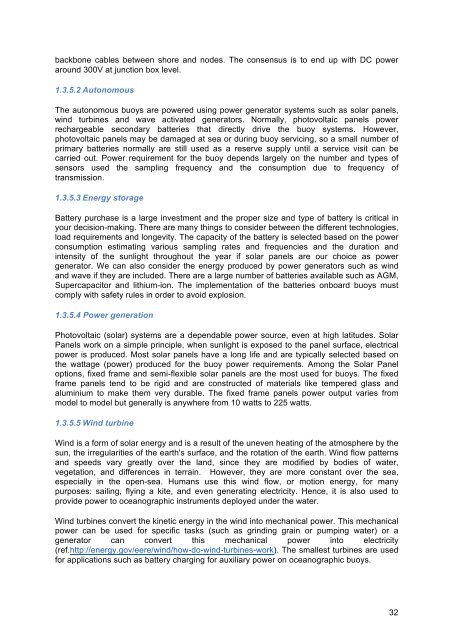Handbook of best practices
Handbook%20of%20best%20practices
Handbook%20of%20best%20practices
Create successful ePaper yourself
Turn your PDF publications into a flip-book with our unique Google optimized e-Paper software.
ackbone cables between shore and nodes. The consensus is to end up with DC power<br />
around 300V at junction box level.<br />
1.3.5.2 Autonomous<br />
The autonomous buoys are powered using power generator systems such as solar panels,<br />
wind turbines and wave activated generators. Normally, photovoltaic panels power<br />
rechargeable secondary batteries that directly drive the buoy systems. However,<br />
photovoltaic panels may be damaged at sea or during buoy servicing, so a small number <strong>of</strong><br />
primary batteries normally are still used as a reserve supply until a service visit can be<br />
carried out. Power requirement for the buoy depends largely on the number and types <strong>of</strong><br />
sensors used the sampling frequency and the consumption due to frequency <strong>of</strong><br />
transmission.<br />
1.3.5.3 Energy storage<br />
Battery purchase is a large investment and the proper size and type <strong>of</strong> battery is critical in<br />
your decision-making. There are many things to consider between the different technologies,<br />
load requirements and longevity. The capacity <strong>of</strong> the battery is selected based on the power<br />
consumption estimating various sampling rates and frequencies and the duration and<br />
intensity <strong>of</strong> the sunlight throughout the year if solar panels are our choice as power<br />
generator. We can also consider the energy produced by power generators such as wind<br />
and wave if they are included. There are a large number <strong>of</strong> batteries available such as AGM,<br />
Supercapacitor and lithium-ion. The implementation <strong>of</strong> the batteries onboard buoys must<br />
comply with safety rules in order to avoid explosion.<br />
1.3.5.4 Power generation<br />
Photovoltaic (solar) systems are a dependable power source, even at high latitudes. Solar<br />
Panels work on a simple principle, when sunlight is exposed to the panel surface, electrical<br />
power is produced. Most solar panels have a long life and are typically selected based on<br />
the wattage (power) produced for the buoy power requirements. Among the Solar Panel<br />
options, fixed frame and semi-flexible solar panels are the most used for buoys. The fixed<br />
frame panels tend to be rigid and are constructed <strong>of</strong> materials like tempered glass and<br />
aluminium to make them very durable. The fixed frame panels power output varies from<br />
model to model but generally is anywhere from 10 watts to 225 watts.<br />
1.3.5.5 Wind turbine<br />
Wind is a form <strong>of</strong> solar energy and is a result <strong>of</strong> the uneven heating <strong>of</strong> the atmosphere by the<br />
sun, the irregularities <strong>of</strong> the earth's surface, and the rotation <strong>of</strong> the earth. Wind flow patterns<br />
and speeds vary greatly over the land, since they are modified by bodies <strong>of</strong> water,<br />
vegetation, and differences in terrain. However, they are more constant over the sea,<br />
especially in the open-sea. Humans use this wind flow, or motion energy, for many<br />
purposes: sailing, flying a kite, and even generating electricity. Hence, it is also used to<br />
provide power to oceanographic instruments deployed under the water.<br />
Wind turbines convert the kinetic energy in the wind into mechanical power. This mechanical<br />
power can be used for specific tasks (such as grinding grain or pumping water) or a<br />
generator can convert this mechanical power into electricity<br />
(ref.http://energy.gov/eere/wind/how-do-wind-turbines-work). The smallest turbines are used<br />
for applications such as battery charging for auxiliary power on oceanographic buoys.<br />
32


